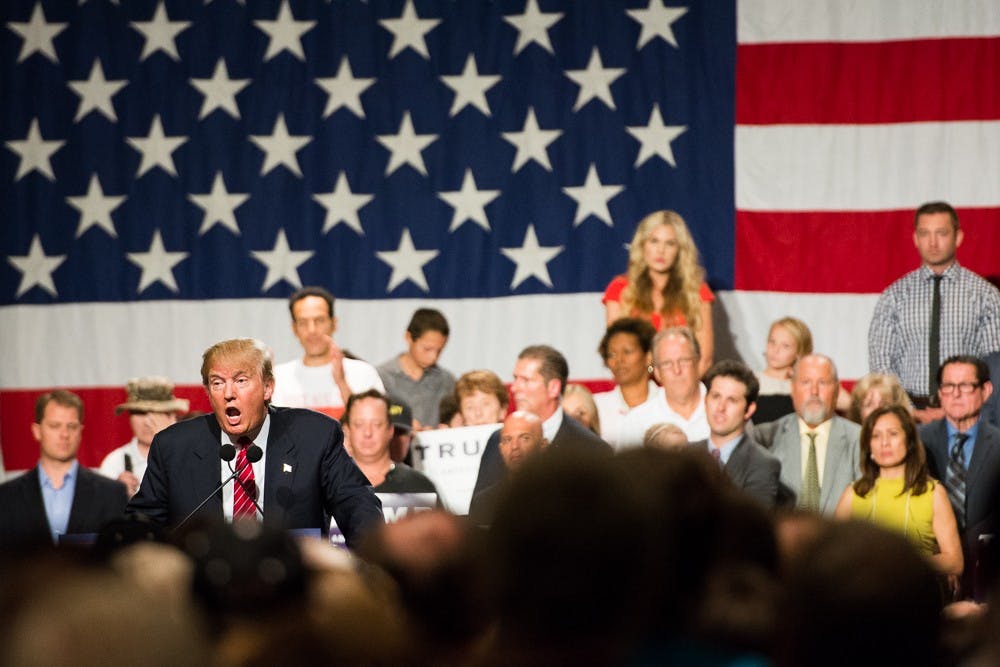As Donald Trump’s approval ratings continue to rise, he is finding yet another way to move even further up in the polls. This time it's by promising to bring down taxes.
"Fair. Simple. Easy. Amazing." These are the four words the Republican presidential candidate has used to describe his four-page tax plan. He left a few words out of his description, if you ask me: empty, confusing, contradicting and broad should be thrown in there, too.
From afar, this plan seems reasonable and promising. Trump's plan includes: reducing the number of tax brackets from seven to four, eliminating estate tax, cutting wasteful spending from the budget, reducing the corporate tax rate to 15 percent, eliminating multiple deductions and penalties and letting the marriage penalty, death tax and alternative minimum tax die.
He also plans to eliminate or reduce a lot of the loopholes that are being used by the elite and special interest groups. Trump has claimed that his plan has potential to lure back companies who are now overseas. Companies like Google and Apple, among others have $2 trillion abroad and through Trump’s plan, they would be compelled to bring their jobs back to America.
Perhaps the most unique part about this plan is that it would allow for “zero” to be a tax bracket, which is unheard of. This is would exempt half of Americans from having a federal income tax burden.
Under Trump’s plan married couples who earn a combined income below $50,000 per year and single individuals who make less than $25,000 per year will be excluded from paying federal income taxes. Trump estimates 75 million households will fall under the tax exemption. In true Trump fashion, those workers will need to send in a form to the IRS with one message: “I win.”
Lowering taxes creates undeniable opportunity for economic growth and lower corporate tax rates have the potential to stimulate the economy. Everything about this plan works. It seems to benefit everyone.
As you peer closer into the details, you can’t help but wonder how this whole thing has any chance at actually being successful.
The biggest beneficiaries seem to be low income workers, but many of those workers currently do not pay federal income taxes anyway.
While cutting the number of tax brackets and lowering taxes for both corporations and individuals seems great, Trump's plan to make up for all of these cuts is not solid enough. He plans to offset the tax cuts by cutting out loopholes and deductions, but has yet to explain how he plans to do that or even specify which loopholes would be eliminated or restricted.
Although I like the idea of Trump going after hedge fund guys, his plan is almost entirely illegitimate. There is no actual substance behind it; it is merely a gamble. Trump is betting on the improvement of the economy as a result of his tax plan and he is depending on increased consumer spending to keep the national debt from rising. He doesn't really have a way of ensuring that.
Trump's plan is simply too good to be true; it's an economic promise to all social classes, and an empty one at that. There is no way to ensure that all social classes will reap equal benefits from this plan because they all benefit in ways that would contradict each other.
Most importantly, there has yet to be a financial explanation of this plan; there are no solid numbers. Trump has a good idea, but it is far from a practical plan.
To be fair, Trump’s ideas are not entirely unique. Fellow Republican presidential candidate Jeb Bush has a similar tax plan that has even wider tax brackets and lower rates than Trump's proposal.
Finally saw Donald's 'tax plan.' Looks familiar! I'm flattered. But he should've stuck with growth & fiscal responsibility.
— Jeb Bush (@JebBush) September 29, 2015
While Trump claims that his tax plan would pay itself off in economic growth as soon as 6 percent a year, Bush says that he can do it at four. Ultimately, tax payers would pay less individually and the government would lose more tax revenue under Bush’s tax plan than under Trump's.
If there's any highlight, it is the incentivizing of economic growth and promotion of work. Ideally Trump’s goal for his tax plan would be to get Americans working, spending and investing in stocks. This is not a bad place to start. If Trump could fill in the blanks and elaborate on the inner financial workings of the plan and its implementation, it could have some serious potential to be a huge improvement from our current tax plan.
Related Links:
Thousands gather at Phoenix Convention Center for Donald Trump rally
Donald Trump relies on misinformation to trick gullible voters
Reach the columnist at alexisberdine@aol.com or follow her on Twitter @AlexisBerdine
Editor’s note: The opinions presented in this column are the author’s and do not imply any endorsement from The State Press or its editors.
Want to join the conversation? Send an email to opiniondesk.statepress@gmail.com. Keep letters under 300 words and be sure to include your university affiliation. Anonymity will not be granted.
Like The State Press on Facebook and follow @statepress on Twitter.




